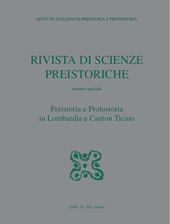Il Paleolitico e il Mesolitico in Lombardia
P. 77-110
This paper is aimed at providing an updated synthesis on the present knowledge of human occupation in Lombardy during the Palaeolithic and the Mesolithic. The possibility to reconstruct a reliable framework is severely biased by the still limited evidence, especially for the most ancient periods. Authors illustrate the most relevant published data for the different periods and trace a critical report on human occupation in the region within the widest context of the first human settlement of Northern Italy. The Lower Palaeolithic is almost unknown, although a lack of evidence does not necessarily mean an absence of occupation. The Middle Palaeolithic is constituted by a handful of sites, both open-air and from cave/rock-shelter contexts and so far mostly represented by small size lithic scatters, sometimes associated with faunal remains.
The recent discovery in 2009 of a frontal bone of H. neanderthalensis on a beach along the Po river near Cremona is also worth mentioning. Also the first part of the Upper Palaeolithic is poorly represented. A possible Aurignacian occupation is indicated by a sole finding with an uncertain attribution while in the following phases - covering the Gravettian and Early Epigravettian - deterioration of climatic conditions related to the LGM could have prevented permanent human settlement. Nevertheless, as far as the plain area is concerned, occupation traces from these phases could be hidden by the thick alluvial covers of the Po river and its main tributaries.
A more consistent record is attested for the latest phase of the Epigravettian testifying the first re-colonization of the Alpine area after the retreat of glaciers from the main valleys as it is attested in Valcamonica. Following the spread of woodlands at mid and high altitudes this process continued in the Mesolithic. The number of known sites shows a significant increase although they appear unevenly distributed and especially concentrated at the eastern side of the region, most probably as a consequence of the more intensive research carried out in this area. Twenty out of around sixty sites have been explored by either stratigraphic trenches or extensive excavations. Such evidence attests for a widespread occupation of the region both during the Sauveterrian and the Castelnovian.
Sites span from the plain area with its varied biotopes to the innermost Alpine territories, where they are located in recurrent and strategic positions for highland mobility and resource availability. Although at the present state of research the Mesolithic record of Lombardy appears less abundant than the one available for the southeastern Alpine sector some recurrent patterns are observed such as a settlement system based on the exploitation of the main alpine valleys and their respective watersheds. Given the high potentiality of the territory of Lombardy for prehistoric research Authors conclude that in order to increase our knowledge on the most ancient settlement of this region a new season of field research should be encouraged. [Publisher's text]
Fait partie de
Rivista di scienze preistoriche : LXXII, supplemento, 2022-
Articles du même numéro (disponibles individuellement)
-
Informations
Code DOI : 10.32097/1165
ISSN: 2282-457X


